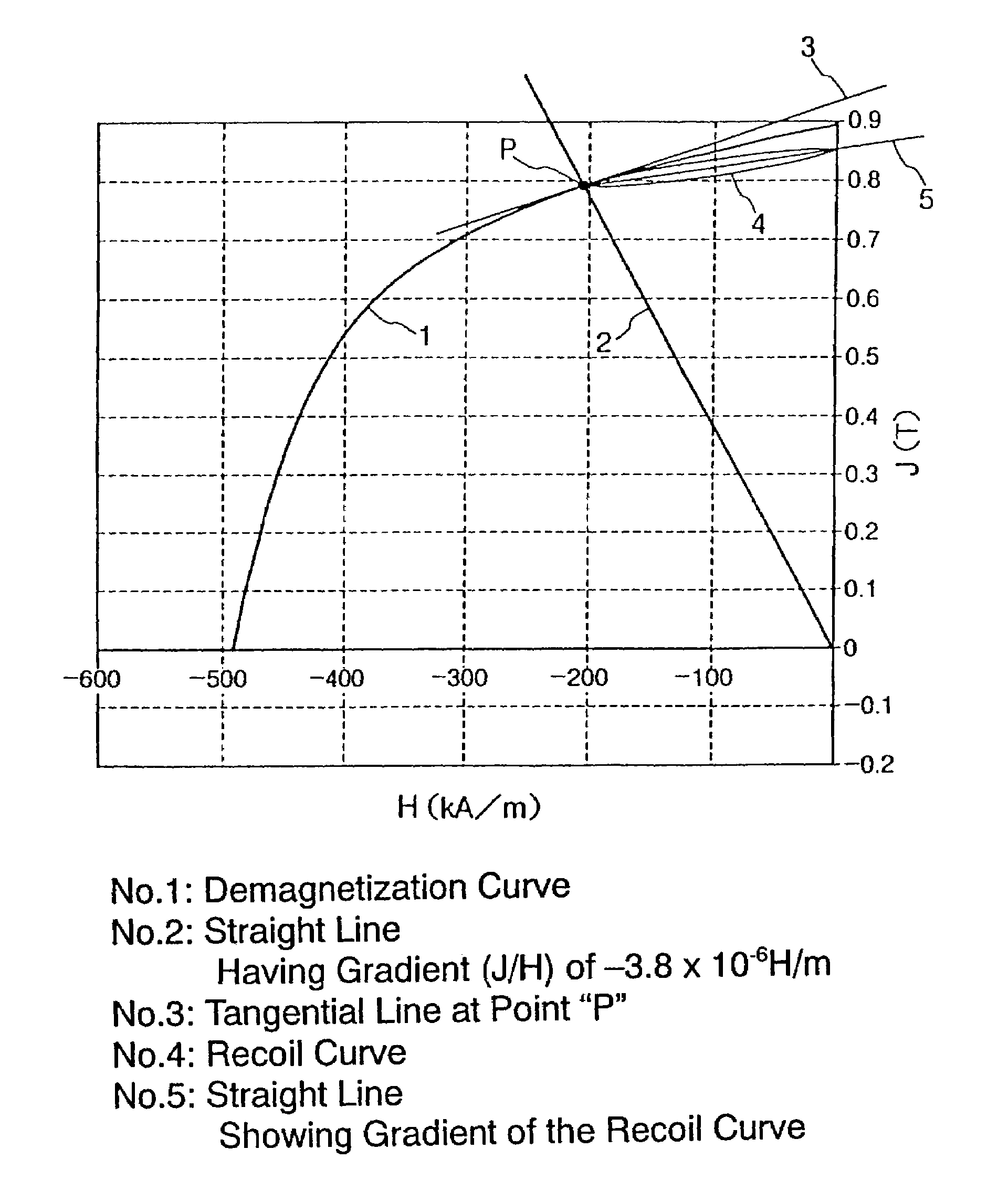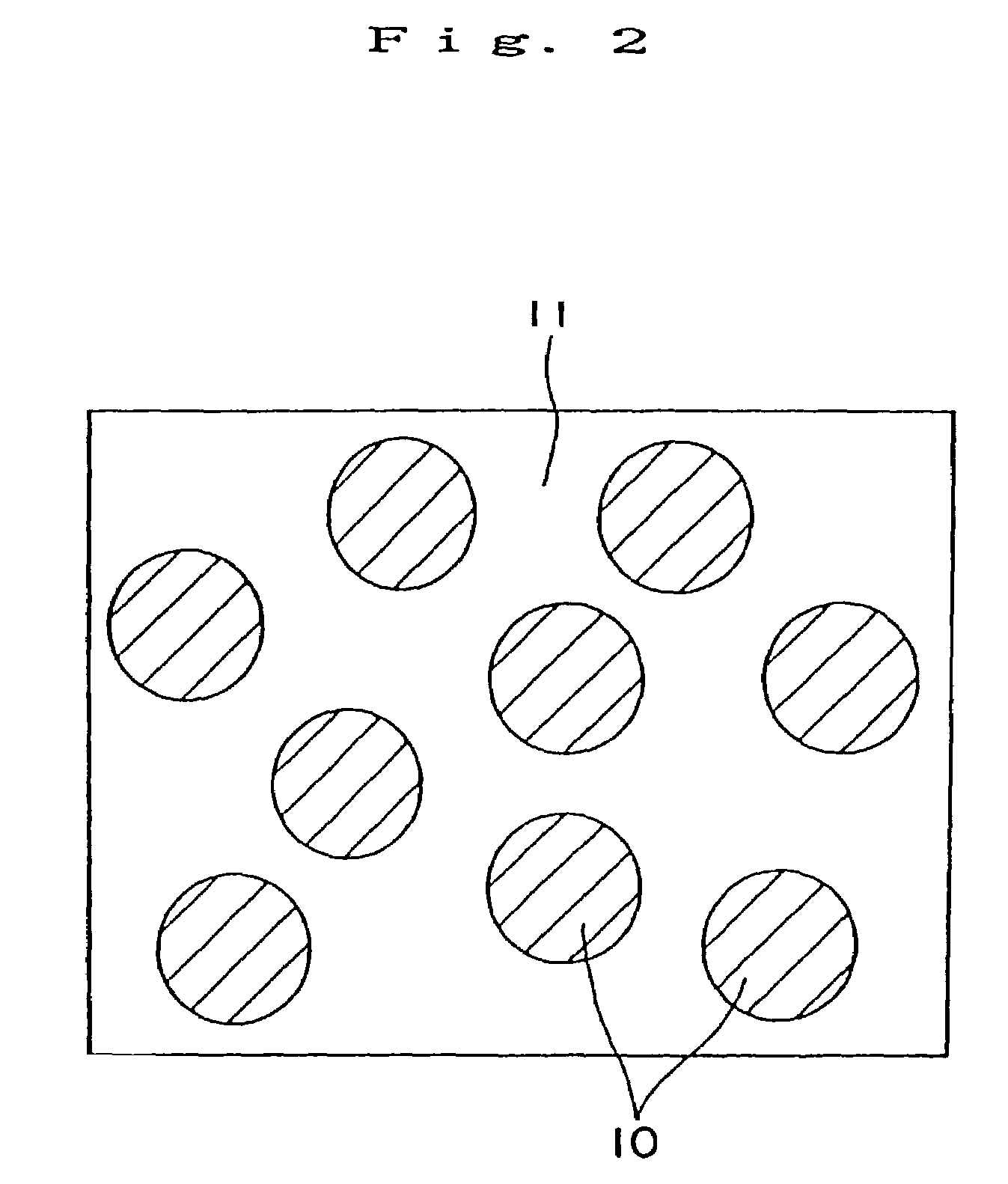Magnetic powder and isotropic bonded magnet
- Summary
- Abstract
- Description
- Claims
- Application Information
AI Technical Summary
Benefits of technology
Problems solved by technology
Method used
Image
Examples
example 1
[0134]Magnetic powders with alloy compositions Nd8.7Fe77.2-wCo8.5B5.6Alw (that is, various types of magnetic powders in which the content w of Al is changed variously) were obtained by the method described below.
[0135]First, each of the materials Nd, Fe, Co, B, and Al was weighed to cast a mother alloy ingot, and a sample of about 15 g was cut out from the ingot.
[0136]A quenched ribbon manufacturing apparatus 1 as shown in FIG. 4 and FIG. 5 was prepared, and the sample was placed in a quartz tube 2 having a nozzle (circular orifice) 3 at the bottom. After evacuating the interior of a chamber in which the quenched ribbon manufacturing apparatus 1 is housed, an inert gas (Ar gas and helium gas) was introduced to obtain an atmosphere with desired temperature and pressure.
[0137]Then, the ingot sample in the quartz tube 2 was melted by high frequency induction heating, the circumferential velocity and the jetting pressure (difference between the inner pressure of the quartz tube 2 and th...
example 2
[0151]Quenched ribbons of which alloy compositions were (Nd1-yPry)8.8FebalCo7.5B5.8Al0.7 (that is, various types of quenched ribbons in which the substitution amount y of Pr is changed variously) were manufactured in the same manner as Example 1, and then the manufactured quenched ribbons were subjected to heat treatment in the argon gas atmosphere at a temperature of 680° C. for 10 minutes. Using the same analyzing method as that used in Example 1, it has been confirmed that the structure of each of the quenched ribbons constitutes a nanocomposite structure.
[0152]Next, in the same manner as Example 1, magnetic powders were obtained from the respective quenched ribbons, and then cylindrical (ring-shaped) isotropic bonded magnets having outer diameter of 20 mm, inner diameter of 18 mm and height of 7 mm were manufactured. The content of the magnetic powder in each of the bonded magnets was about 96.8 wt %. Further, the density of each of the bonded magnets was about 6.18 Mg / m3.
[0153]...
example 3
[0159]Quenched ribbons of which alloy compositions were ((Nd0.5Pr0.5))zDy1-z)9.0Feba1Co7.7B5.6Al0.5 (that is, various types of quenched ribbons in which the substitution amount (1-z) of Dy is changed variously) were manufactured in the same manner as Example 1, and then the manufactured quenched ribbons were subjected to heat treatment in the argon gas atmosphere at a temperature of 680° C. for 12 minutes. Using the same analyzing method as that used in Example 1, it has been confirmed that the structure of each of the quenched ribbons constitutes a nanocomposite structure.
[0160]Next, in the same manner as Example 1, magnetic powders were obtained from the respective quenched ribbons, and then cylindrical (ring-shaped) isotropic bonded magnets having outer diameter of 20 mm, inner diameter of 18 mm and height of 7 mm were manufactured. The content of the magnetic powder in each of the bonded magnets was about 96.8 wt %. Further, the density of each of the bonded magnets was about 6....
PUM
| Property | Measurement | Unit |
|---|---|---|
| Nanoscale particle size | aaaaa | aaaaa |
| Magnetic permeability | aaaaa | aaaaa |
| Content | aaaaa | aaaaa |
Abstract
Description
Claims
Application Information
 Login to View More
Login to View More - R&D
- Intellectual Property
- Life Sciences
- Materials
- Tech Scout
- Unparalleled Data Quality
- Higher Quality Content
- 60% Fewer Hallucinations
Browse by: Latest US Patents, China's latest patents, Technical Efficacy Thesaurus, Application Domain, Technology Topic, Popular Technical Reports.
© 2025 PatSnap. All rights reserved.Legal|Privacy policy|Modern Slavery Act Transparency Statement|Sitemap|About US| Contact US: help@patsnap.com



